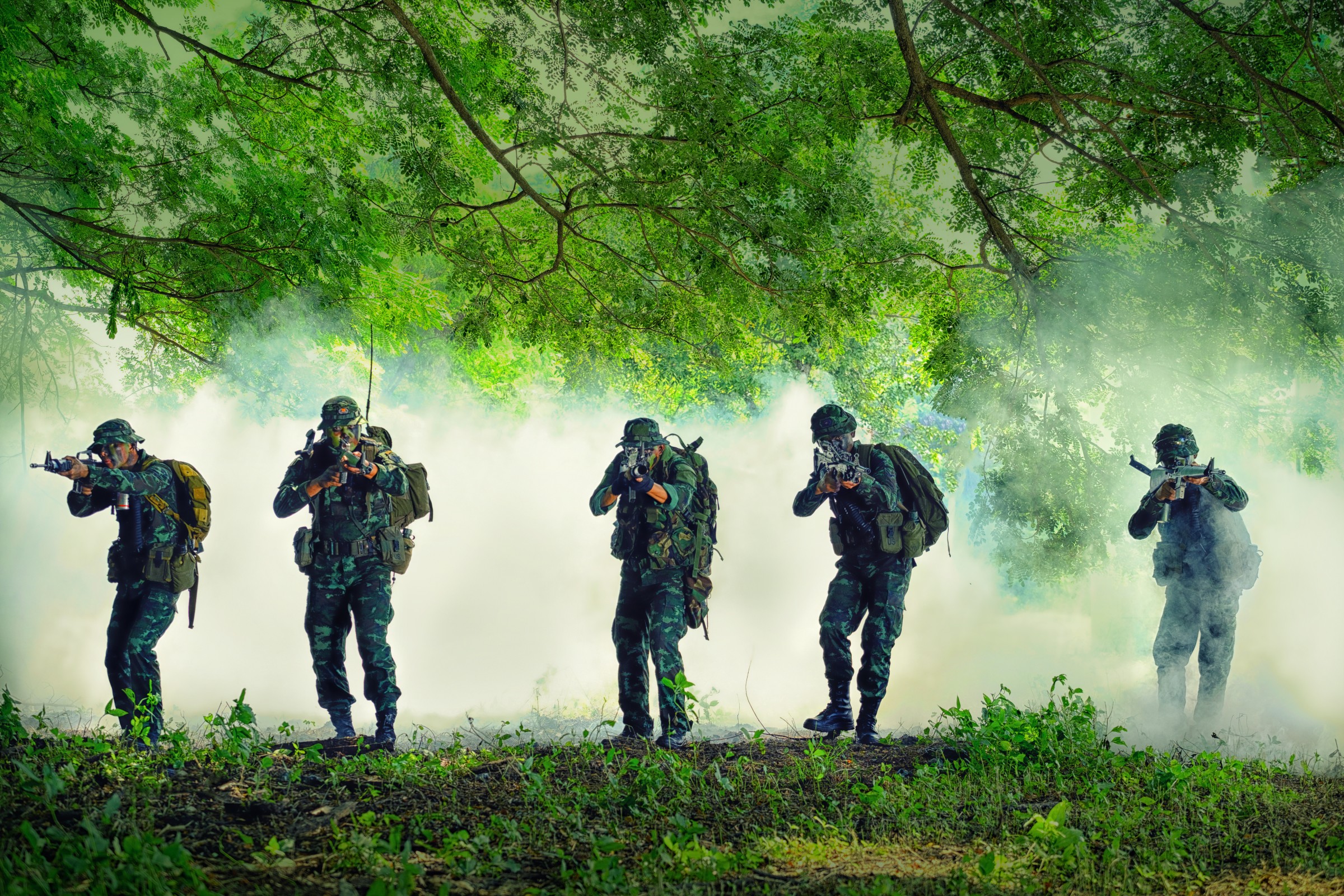Military Training Programs – Leveraging AI and Technology for the Future of Defense Training

In modern defense, the success of military operations depends on the readiness and skill of personnel. This readiness is achieved through rigorous military training programs that prepare soldiers for the challenges they may face on the battlefield. However, traditional methods of training are no longer sufficient to address the complexities of today’s multi-domain operations, hybrid warfare, and emerging threats. As military forces evolve, so too must their training methods.
The incorporation of artificial intelligence (AI), virtual reality (VR), augmented reality (AR), and advanced data analytics into military training programs has transformed how soldiers are prepared for real-world combat. These technologies enable more immersive, flexible, and effective training environments that can simulate various scenarios with unprecedented accuracy and realism.
In this blog, we will explore how modern military training programs are leveraging AI and technology to revolutionize defense training, the impact of these innovations on military preparedness, and how platforms like AiDOOS are driving innovation in defense training solutions.
Historically, military training has been centered on physical drills, field exercises, and classroom instruction. While these methods remain essential, they are often limited in scope and fail to simulate the full spectrum of modern warfare, especially in dynamic and unpredictable environments. With the rise of digital technologies, military training has shifted toward more flexible, data-driven approaches that offer tailored and adaptive learning experiences.
Today’s military training programs emphasize:
Personalized Learning Paths: AI-based systems analyze the strengths and weaknesses of individual trainees to develop personalized training plans. This approach ensures that each soldier is trained according to their specific needs and capabilities, resulting in more efficient and targeted skill development.
Simulation and Immersive Technologies: Virtual and augmented reality technologies allow soldiers to train in realistic combat environments without leaving their bases. These immersive environments simulate urban combat, disaster relief, hostage situations, and cyber warfare scenarios, allowing trainees to experience real-world challenges in a controlled, safe environment.
Data-Driven Decision Making: Military training programs are increasingly using data analytics to assess performance metrics. By collecting and analyzing data from training sessions, commanders can identify areas for improvement, optimize training strategies, and better prepare soldiers for real-world combat.
Remote and Continuous Training: Remote training solutions are becoming more prevalent, especially with the use of cloud-based platforms and virtual classrooms. These solutions allow soldiers to access training materials from any location, enabling continuous learning and skills development, even in remote or hostile environments.
As the demands on military personnel grow, so too does the need for more advanced training tools. Here are some of the key technologies transforming military training programs:
AI-Driven Training Programs: Artificial intelligence plays a pivotal role in modern military training by providing personalized training experiences based on real-time data. AI can assess a soldier’s performance, offer recommendations for improvement, and even simulate enemy behaviors in combat scenarios. AI-based systems also provide feedback during live drills, helping trainees adjust their tactics on the fly.
AI enables military trainers to develop more adaptive training programs, ensuring that soldiers are not only trained for today’s challenges but also equipped to handle emerging threats.
Virtual and Augmented Reality (VR/AR): Virtual reality (VR) and augmented reality (AR) are widely used to create realistic training environments. VR immerses soldiers in combat simulations, allowing them to train in hazardous or high-stress situations without the risks associated with live combat. AR overlays digital information onto the physical world, providing real-time data during training exercises, such as navigation cues or weapon targeting assistance.
These immersive technologies provide soldiers with practical experience in diverse environments, from urban warfare to humanitarian missions, improving their decision-making skills and adaptability.
Simulation-Based Training: Military forces increasingly use simulation-based training to replicate combat scenarios, allowing trainees to experience complex, multi-faceted operations in a controlled setting. Simulators can mimic everything from flight operations and armored vehicle combat to tactical decision-making processes in the heat of battle.
Simulation technologies provide soldiers with valuable experience and muscle memory without the need for live drills or physical deployments, reducing costs and risks.
Cloud-Based Training Platforms: With the advent of cloud computing, military organizations are adopting cloud-based training platforms that allow soldiers to access training resources remotely. Cloud-based systems enable the centralization of training materials, making it easier to update content and track the progress of individual soldiers.
These platforms also enable collaboration between military units stationed in different locations, allowing for joint training exercises and knowledge sharing.
Data Analytics for Performance Assessment: Data analytics is used to monitor and analyze a soldier’s performance during training sessions. From tracking reaction times and accuracy in weapons handling to measuring endurance during physical exercises, data-driven insights help commanders identify which skills need improvement.
The use of analytics allows for a more scientific approach to training, providing objective performance metrics that can be used to tailor future training sessions and ensure better outcomes.
The integration of AI and immersive technologies into military training has several strategic benefits:
Realistic and Adaptive Training: AI-enhanced training programs create more realistic scenarios that can adjust to the actions of the trainee, providing a more dynamic and effective learning experience. Soldiers are better prepared for real-world operations because the training adapts to their evolving skill levels and situational needs.
Cost-Efficiency: Training in virtual environments reduces the costs associated with live drills, such as ammunition, fuel, and travel expenses. It also minimizes the wear and tear on military equipment, reducing maintenance and replacement costs.
Reduced Risk: By simulating combat scenarios in virtual environments, soldiers can practice high-risk maneuvers and decision-making without endangering their lives. This allows for more frequent and intense training, particularly in hazardous or unconventional scenarios.
Scalable Training Programs: AI and cloud-based platforms make it possible to scale military training programs to meet the needs of large, dispersed forces. These programs can be updated in real-time to address emerging threats and new tactics, ensuring that soldiers are always prepared for the latest challenges.
AiDOOS provides defense organizations with access to a global network of experts specializing in AI, simulation technologies, data analytics, and virtual reality. By leveraging the expertise of these specialists, military organizations can develop cutting-edge training programs that incorporate the latest technological advancements.
For instance, AI-driven training platforms powered by AiDOOS enable military forces to create personalized and adaptive training experiences for soldiers, ensuring that each trainee receives tailored feedback and instruction. Additionally, AiDOOS supports the development of VR/AR-based simulations, which provide immersive environments for soldiers to hone their skills in a variety of combat and non-combat scenarios.
AiDOOS’s cloud-based approach also enables military organizations to rapidly deploy remote training solutions, ensuring that soldiers across the globe can access training resources and participate in joint exercises without the need for physical deployment.
As military operations continue to evolve, the future of military training will be shaped by advances in AI, simulation technologies, and data analytics. The next generation of soldiers will be trained using even more immersive and adaptive systems, with AI capable of simulating more complex and realistic adversaries, environments, and operational scenarios.
Virtual reality, augmented reality, and mixed reality technologies will become even more advanced, offering soldiers near-real-world experiences in their training. The integration of cloud-based learning platforms and AI-powered analytics will ensure that training is more flexible, data-driven, and personalized to each soldier’s needs.
Military training programs are the foundation of operational readiness, and the integration of AI, VR/AR, and data analytics is transforming how soldiers are trained for the challenges of modern warfare. By creating more immersive, adaptive, and personalized training experiences, these technologies ensure that military personnel are better equipped to face real-world threats and make faster, more informed decisions.
Through AiDOOS, defense organizations can accelerate the development and deployment of advanced military training solutions, ensuring that their forces remain at the cutting edge of readiness and performance.

For modern telecom enterprises, delivering exceptional QoS is no longer optional—it’s a brand differentiator and a strategic lever for growth. Static provisioning models won’t cut it in a world of hyper-dynamic data usage.